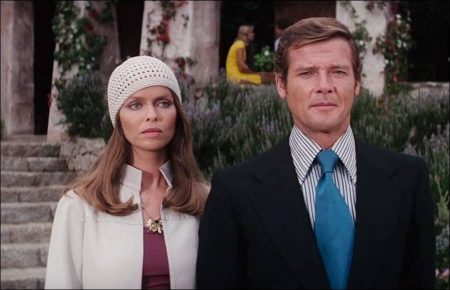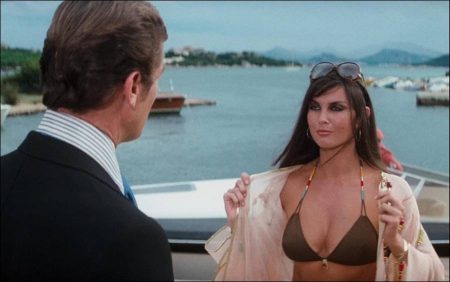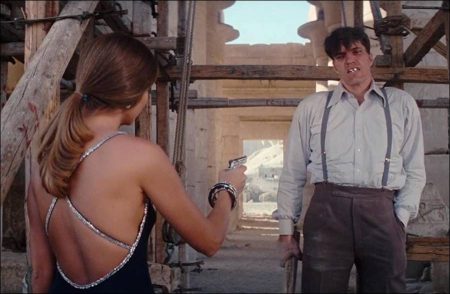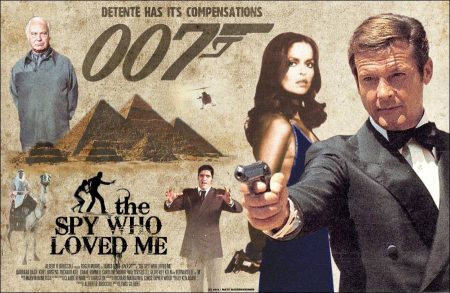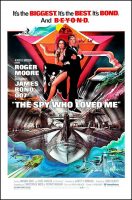The Spy Who Loved Me movie storyline. A shipping magnate, Karl Stromberg, has employed two brilliant scientists to develop a submarine tracking system. Once it is finished, he assures them of multimillion-dollar payouts to their Swiss bank accounts, but not before ruthlessly murdering his young assistant by dumping her into a tank inhabited by a man-eating tiger shark. Shortly afterward, British and Soviet submarines vanish while on routine moves, and Bond is called into action.
Also called to duty is his Soviet counterpart, Major Anya Amasova. Though they are initially working against each other, the British Secret Service and K.G.B. begin to work together to find the microfilm that contains the tracking system. Bond and Anya must deal with Stromberg’s goons, who have been ordered to eliminate anyone who comes into contact with the microfilm. One of these is Jaws, a seven-foot towering Goliath with metal teeth. When a U.S. submarine is also hijacked, Bond and Anya must move quickly to avert World War III, which Stromberg is hoping to start.
The Spy Who Loved Me is a 1977 spy film, the tenth in the James Bond series produced by Eon Productions. It is the third to star Roger Moore as the fictional secret agent James Bond. The film co-stars Barbara Bach and Curd Jürgens and was directed by Lewis Gilbert, from a screenplay by Christopher Wood and Richard Maibaum.
The film takes its title from Ian Fleming’s 1962 novel The Spy Who Loved Me, the tenth book in the James Bond series, though it does not contain any elements of the novel’s plot. The storyline involves a reclusive megalomaniac named Karl Stromberg, who plans to destroy the world and create a new civilisation under the sea. Bond teams up with a Russian agent, Anya Amasova, to stop the plans, all while being hunted by Stromberg’s powerful henchman, Jaws.
It was shot on location in Egypt (Cairo and Luxor) and Italy (Costa Smeralda, Sardinia), with underwater scenes filmed at the Bahamas (Nassau), and a new soundstage built at Pinewood Studios for a massive set which depicted the interior of a supertanker. The Spy Who Loved Me was well received by critics, who saw the film as a return to form for the franchise, and also praising Moore’s performance. The soundtrack composed by Marvin Hamlisch also met with success. The film was nominated for three Academy Awards amid many other nominations and novelised in 1977 by Christopher Wood as James Bond, The Spy Who Loved Me.
About the Production
Given the relatively poor financial returns and generally unfavourable response of critics to its predecessor, The Man with the Golden Gun (1974), The Spy Who Loved Me was a pivotal film for the Bond franchise. The project was plagued with difficulties from the outset, the first being the departure of Bond producer Harry Saltzman, who was forced to sell his half of the Bond film franchise in 1975 for £20 million. Saltzman had branched out into several other ventures of dubious promise and consequently was struggling through personal financial reversals unrelated to Bond. This was exacerbated by the twin personal tragedies of his wife’s terminal cancer and many of the symptoms of clinical depression in himself.
Another troubling aspect of the production was the difficulty in obtaining a director. The producers approached Steven Spielberg, who was in post-production for Jaws, but ultimately decided against him.[5][6] The first director attached to the film was Guy Hamilton, who directed the previous three Bond films as well as Goldfinger, but he left after being offered the opportunity to direct the 1978 film Superman, although Richard Donner took over the project. Eon Productions later turned to Lewis Gilbert, who had directed the earlier Bond film You Only Live Twice.
With a director finally secured, the next hurdle was finishing the script, which had gone through several revisions by numerous writers. The initial villain of the film was Ernst Stavro Blofeld; however Kevin McClory, who owned the film rights to Thunderball, obtained an injunction barring Eon Productions from using the character of Blofeld or his international criminal organisation SPECTRE, which delayed production of the film further.
The villain was later changed from Blofeld to Stromberg so that the injunction would not interfere with the production. Christopher Wood was later brought in by Gilbert to complete the script. Although Fleming had requested that no elements from his original book be used, the film characters of Jaws and Sandor are based on the novel characters Sol Horror and Sluggsy Morant, respectively. Horror is described as having steel-capped teeth, while Sluggsy had a clear bald head.
Since Ian Fleming permitted Eon to use only the name of his novel but not the actual plot, Fleming’s name was moved for the first time from above the film’s title to above “James Bond 007”. His name reverted to the traditional location for Moonraker, the last Eon Bond film based on a Fleming novel before 2006’s Casino Royale. However, the credit style first used in The Spy Who Loved Me has been used on all Eon Bond films since For Your Eyes Only, including Casino Royale.
The Spy Who Loved Me (1977)
Directed by: Lewis Gilbert
Starring: Roger Moore, Barbara Bach, Curd Jürgens, Richard Kiel, Caroline Munro, Geoffrey Keen, Michael Billington, Bernard Lee, Edward de Souza, Valerie Leon, Vernon Dobtcheff
Screenplay by: Christopher Wood, Richard Maibaum
Production Design by: Ken Adam
Cinematography by: Claude Renoir
Film Editing by: John Glen
Set Decoration by: Hugh Scaife
Art Direction by: Peter Lamont
Makeup Department: Paul Engelen, Barbara Ritchie, Katharina Kubrick
Music by: Marvin Hamlisch
MPAA Rating: None.
Distributed by: United Artists
Release Date: July 13, 1977 (USA)
Visits: 230
